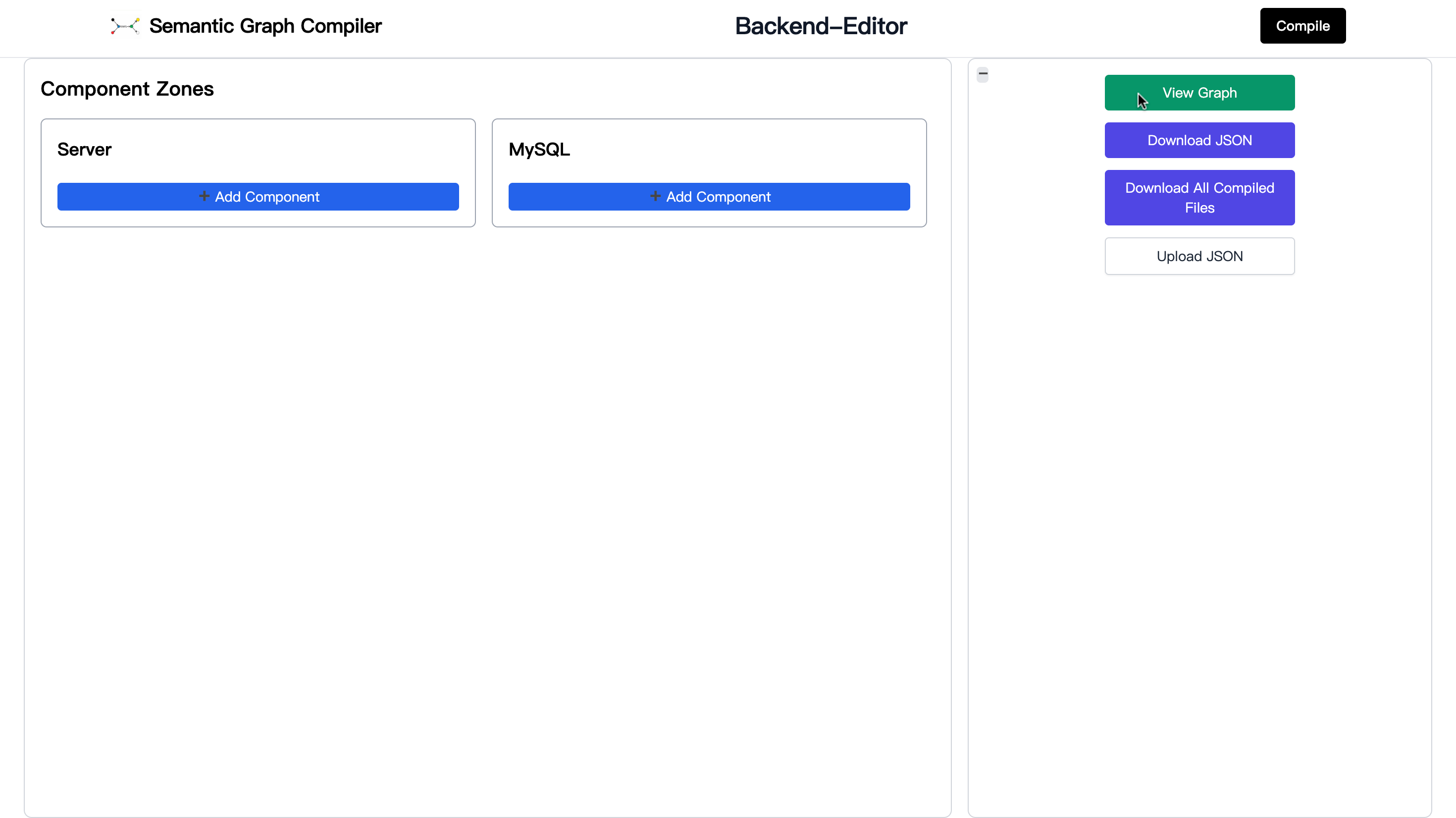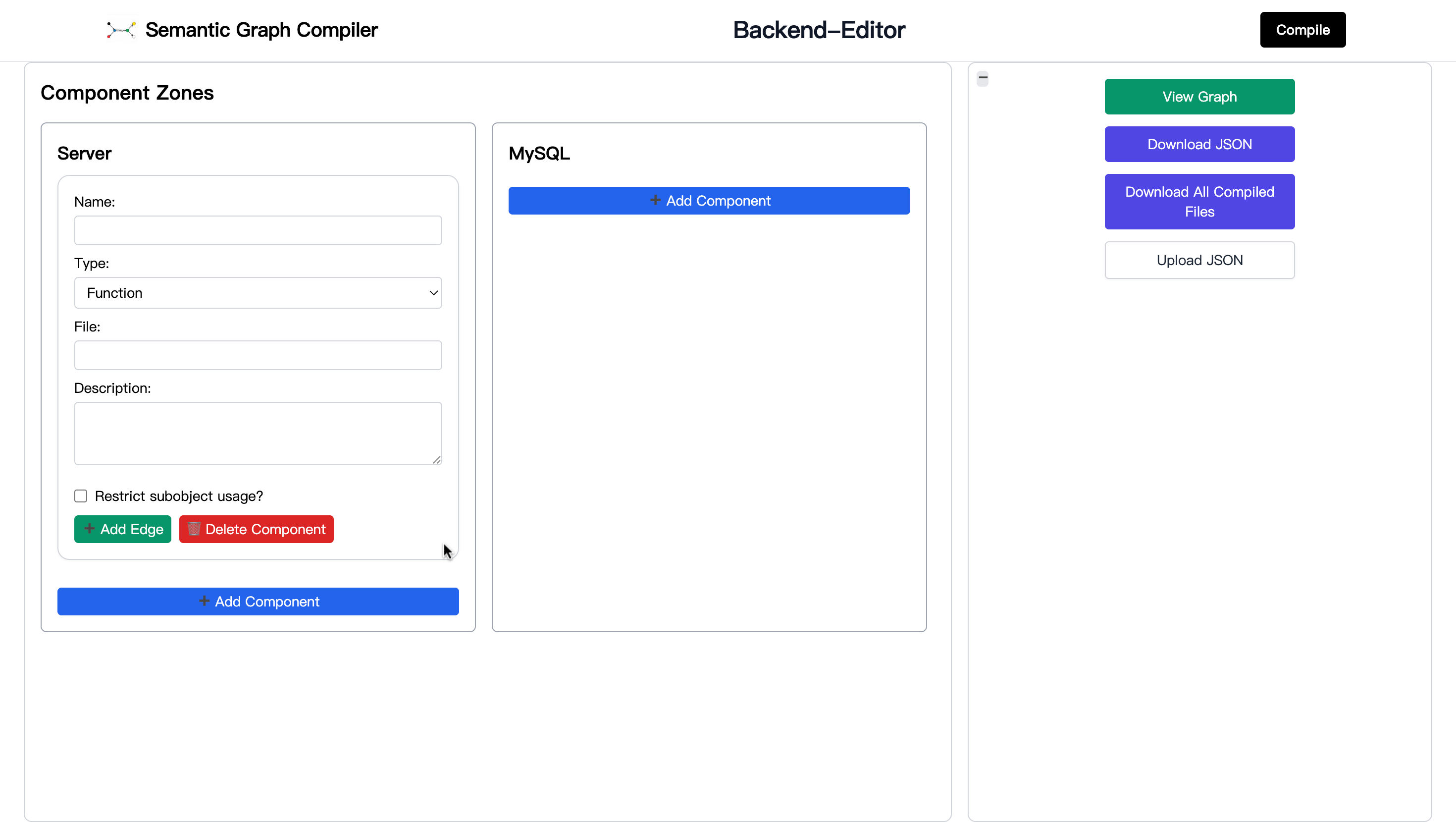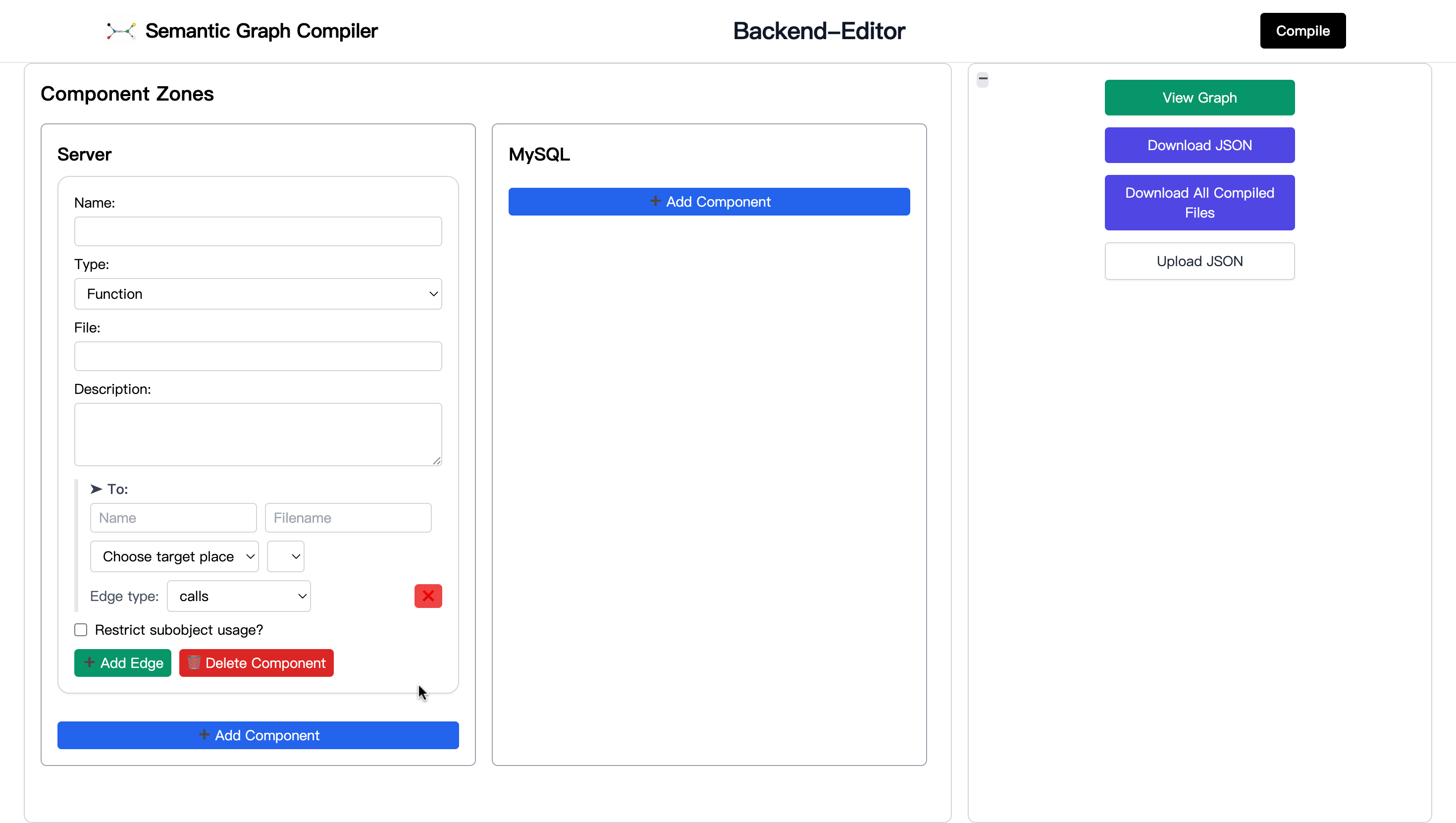Semantic Graph Compiler
Now supports Node.js + Express + MySQL
The Semantic Graph Compiler (SGC) is a powerful developer tool for structurally defining, validating, and compiling complex backend architecture — with automatic graph visualization.
The compiled output is a set of plain-text prompts optimized for large language models (LLMs), such as ChatGPT, enabling them to generate precise, context-aware backend code.
Unlike drag-and-drop tools, SGC lets you build backend architecture through a structured editor — using buttons, forms, and guided input to generate valid semantic graph JSON.
Each semantic graph is stored as a single JSON file, following a simple and consistent schema.
How it works:
SGC takes a semantic graph—a single JSON file describing your application's structure—as input.
This file contains two main arrays:
-
nodes: An array of node objects. Each object represents a component in your system. Components are distinguished by their type field, which indicates the role or category of each node. -
edges: An array of edge objects. Each object describes a directed connection between nodes, expressing relationships such as function calls. These relationships are categorized using a variety of edge types, each representing a specific kind of interaction or dependency.
{
"nodes": [ ... ], // array of node objects
"edges": [ ... ] // array of edge objects
}
Node Structure
To ensure successful compilation, every node must include all required fields with correct data types.
Detailed explanations for each field are provided below.
nametypeplaceTypeServer or MySQL (case-insensitive). Indicates whether the node is located on the general server or the MySQL server.
filenamedescriptionisRestrictedIf set to
true, this node may only access explicitly permitted subcomponents of nodes to which it has outgoing edges.When
false, the node can freely access any subcomponent of the nodes it points to.
restrictedObjectsThis field is only relevant when
isRestricted is set to true.Each object typically includes the target node's basic information, along with a
allowedSubobjects array listing the allowed subcomponents.Nodes that are not connected by an outgoing edge should not be referenced in this array.
id
Each node must include all fields above with the correct type.
Example of a valid node:
{
"name": "post_unsendlike_handler",
"type": "EndpointHandler",
"placeType": "Server",
"filename": "./application/index.js",
"description": "Input:\n\n(req, res)\n\nReturn:\nAnything (flexible)\n\nLogic:\nFirst, extract username and token from req.cookies.\nThen, use sqldatacenter.Verify_LoginToken to verify the user's identity.\n\nIf authentication is successful:\n\nUse sqldatacenter.searchuserIDbyusername to retrieve the corresponding user_id.\n\nExtract post_id from req.body.\n\nCall sqldatacenter.unsendlike with user_id and post_id.\n\nIf everything succeeds, respond with:\n{ \"state\": \"success\" }\nIf any step fails (e.g., identity verification fails), respond with:\n{ \"state\": \"fail\" }",
"isRestricted": true,
"restrictedObjects": [
{
"id": "filename:./application/index.js|name:sqldatacenter|placeType:Server|type:GlobalVariable",
"name": "sqldatacenter",
"filename": "./application/index.js",
"placeType": "Server",
"type": "GlobalVariable",
"allowedSubobjects": [
"Verify_LoginToken",
"searchuserIDbyusername",
"unsendlike"
]
}
],
"id": "filename:./application/index.js|name:post_unsendlike_handler|placeType:Server|type:EndpointHandler"
}
Node Types
Each node in the semantic graph has a specific type that determines its behavior.
The following is a complete set of all node types currently supported by SGC:
Function
A general-purpose backend function node. Ideal for encapsulating logic, reusable operations, and utility methods.
EndpointHandler
A specialized function that handles incoming HTTP/HTTPS requests for a specific API route.
Although technically a function, an EndpointHandler is treated as a distinct node type because it serves as the boundary logic for an API route.
APICreatorFunction
A higher-order function that dynamically generates multiple API endpoints.
This type is still under active development — in the future, it will be able to point to a dedicated APIEndpointsGroup node that encapsulates the generated endpoints for better organization and visualization.
APIEndpoint[GET]
Represents a GET API endpoint. It defines the route path and method, while the actual request-handling logic is delegated to a connected EndpointHandler.
APIEndpoint[POST]
Represents a POST API endpoint. It defines the route path and method, while the actual request-handling logic is delegated to a connected EndpointHandler.
APIEndpoint[USE]
Represents an Express.js middleware registration using app.use(...). It defines a middleware layer that executes before route-specific handlers.
server_file
Represents an actual server-side code file. Other nodes can write to it or read from it.
GlobalVariable
Defines a global variable in a file.
Table
Represents a MySQL table that can be read from or written to using read / write edge types.
Edge Types
Edges connect nodes and describe their relationship. Each edge has a type that defines its role in the graph.
calls
Represents a direct invocation from the source node to the target node. Both nodes must be located within the same file — this is commonly used when one function calls another, or when accessing a shared GlobalVariable.
This edge type expresses local runtime dependencies rather than static imports.
owns
Represents a semantic ownership relationship, where the source node contains or groups other nodes as its members.
Commonly used when a GlobalVariable wraps multiple Function nodes — for example, when functions are exposed as properties of an object.
The source and target nodes must be located within the same file.
In this relationship, the source node is considered to own the target node as a subcomponent.
writes_server_file
Indicates that the source node writes content to the target server_file, such as generating an image, saving a JSON file.
reads_server_file
Indicates that the source node reads content from the target server_file, such as loading an HTML template, a JSON configuration file, or a static image.
This edge type is used when server-side logic depends on the contents of an existing file.
reads_globalVar
Indicates that the source node accesses the value of the target GlobalVariable.
This edge type represents a read-only dependency on shared constants or reusable objects.
The source and target nodes must be located within the same file.
writes_globalVar
Indicates that the source node modifies the target GlobalVariable.
The source and target nodes must be located within the same file.
reads_table
Indicates that the source node reads data from the target Table in the MySQL server.
The operation is performed through a database connection, and the source node is usually a Function that executes a query.
writes_table
Indicates that the source node modifies the target Table in the MySQL server by performing a write operation, such as INSERT, UPDATE, or DELETE.
The operation is carried out through a database connection, and the source node is usually a Function that handles data mutations.
handled_by
Indicates that the source node, typically an APIEndpoint[GET], [POST], or [USE], is handled by the target EndpointHandler node.
This edge connects a route definition to the function that implements its logic.
The source and target nodes must be located within the same file.
rate_limited_by
Indicates that the source node, typically an APIEndpoint, is protected by a rate-limiting mechanism implemented in the target node.The source and target nodes must be located within the same file.
imports
Indicates that the source node imports the target node using static import syntax, making it available within the local file context.
This edge is used to represent cross-file references, and the source and target nodes must be located in different files.
Through this connection, the source node can access the logic and functionality defined in the target node.
The source and target nodes must be located in different files.
Compilation Error Types
During compilation, the Semantic Graph Compiler (SGC) validates the semantic graph structure. If invalid inputs are detected, errors are returned in the following formats:
1. MissingField
Triggered when a node is missing a required field such as name or filename.
node: 'filename:./application/sqldatacenter.js|name:|placeType:Server|type:GlobalVariable' has empty or non-string field 'name'
2. DuplicateNodeId
Two or more nodes share the same id, which is not allowed.
Found duplicate node IDs: "./application/index.js|name:get_userlikepost_handler|placeType:Server|type:EndpointHandler"
3. CycleDetected
[CycleDetected Error]: Found cycle: "filename:./application/index.js|name:/userlikepost|placeType:Server|type:APIEndpoint[GET]" → "filename:./application/index.js|name:get_userlikepost_handler|placeType:Server|type:EndpointHandler" → "filename:./application/index.js|name:alpha|placeType:Server|type:Function"
4. IllegalEdge
Tip: Scroll left/right to view the full content.
[IllegalEdge Error]: Edge [filename:./application/sqldatacenter.js|name:sqlusername|placeType:Server|type:GlobalVariable---->filename:fhgj|name:fkhgj|placeType:Server|type:Function](type: calls) is illegal. Edges of this type can't span across different files.
[IllegalEdge Error]: Edge [filename:./application/sqldatacenter.js|name:sqlusername|placeType:Server|type:GlobalVariable---->filename:fhgj|name:fkhgj|placeType:Server|type:Function](type: calls) is illegal. Node "filename:fhgj|name:fkhgj|placeType:Server|type:Function" doesn't exist
[IllegalEdge Error]: Edge [filename:./application/sqldatacenter.js|name:fs|placeType:Server|type:GlobalVariable---->filename:dfhgj|name:gcnhv|placeType:Server|type:Function](type: imported) is illegal. Node "filename:dfhgj|name:gcnhv|placeType:Server|type:Function" doesn't exist
5. FormatError
The graph contains one or more formatting errors, such as edges referencing nodes that do not exist, or having invalid structure.
Below are raw error examples.
Tip: Scroll left/right if the message is too long.
FormatError: node "filename:./application/sqldatacenter.js|name:mysql|placeType:Server|type:GlobalVariable" has type 'undefined', which is not in the allowed type list.
FormatError: edge ["filename:./application/sqldatacenter.js|name:mysql|placeType:Server|type:GlobalVariable" ----> "filename:mysql2|name:module|placeType:Server|type:GlobalVariable"] field 'type' is different from node "filename:./application/sqldatacenter.js|name:mysql|placeType:Server|type:GlobalVariable".
FormatError: edge ["filename:./application/sqldatacenter.js|name:pool|placeType:Server|type:GlobalVariable" ----> "filename:./application/sqldatacenter.js|name:mysql|placeType:Server|type:GlobalVariable"] field 'type' is different from node "filename:./application/sqldatacenter.js|name:mysql|placeType:Server|type:GlobalVariable".
How To Use Semantic Graph Editor
We only support Backend Editor now
Backend Editor (Node.js+Express+MySQL)
The graph below is the initial screen of the editor. You can start by clicking the Upload JSON button on the right to load an existing semantic graph in JSON format.
After editing your components and connections, you can click Download JSON to export your graph. If you want to view the visual structure of current graph, click View Graph.
Finally, clicking Compile will validate and compile the current graph directly from the editor.
The editor is divided into two main zones: the Server zone and the MySQL zone. You can create and modify nodes and edges in both zones.

After clicking Add Component, a new node will appear as shown in the image below. (In this system, a component is equivalent to a node.)
You can then add an edge from this node by clicking Add Edge. This means you are creating an edge that starts from the node.

After clicking Add Edge, the interface will appear as shown below. You need to select the Edge Type, and specify the target node's name, filename, placeType (i.e. target place), and type to determine which node this edge should point to.

When you check Restrict subobject usage, the component’s isRestricted property will be set to true.
As a result, a new section called Subobject Restriction Settings will appear, as shown below.
This section allows you to configure the restrictedObjects property mentioned earlier.
Clicking Add Restricted Object will add an element to the restrictedObjects array.
You need to fill in the four fields above so the system knows which object’s usage should be restricted.
For each restricted object, you’ll see a section below labeled Allowed Subobject Name. This field lets you specify which subobject names are permitted when this object is used.
You can click Add Allowed Subobject to add more entries of this type.

How To Use Compiled Files
Once you’ve compiled your semantic graph using SGC at Semantic Graph Editor, the output will be a set of plain-text .txt files containing well-structured, AI-targeted prompts—one for every component in that file—ordered precisely according to the graph’s dependency edges.
You can manually copy each individual prompt into a language model such as ChatGPT or Claude, and paste the generated code back into the corresponding part of your codebase. Do not paste the entire file at once—each prompt is meant to be used separately for its specific component.
In the future, this copy-and-paste step may be automated by the server, allowing SGC to send prompts to the LLM and insert the generated code directly into the output structure.
Each compiled prompt file is named based on the filename you provided in the graph. To ensure file system compatibility, certain characters are transformed:
- Every
.in the filename will be replaced withDOT. - All
/characters (i.e., folder separators) are replaced with double underscores__. - Other characters that are invalid in filenames (e.g.,
\,:,*,?,",<,>,|) are replaced with underscores_.
